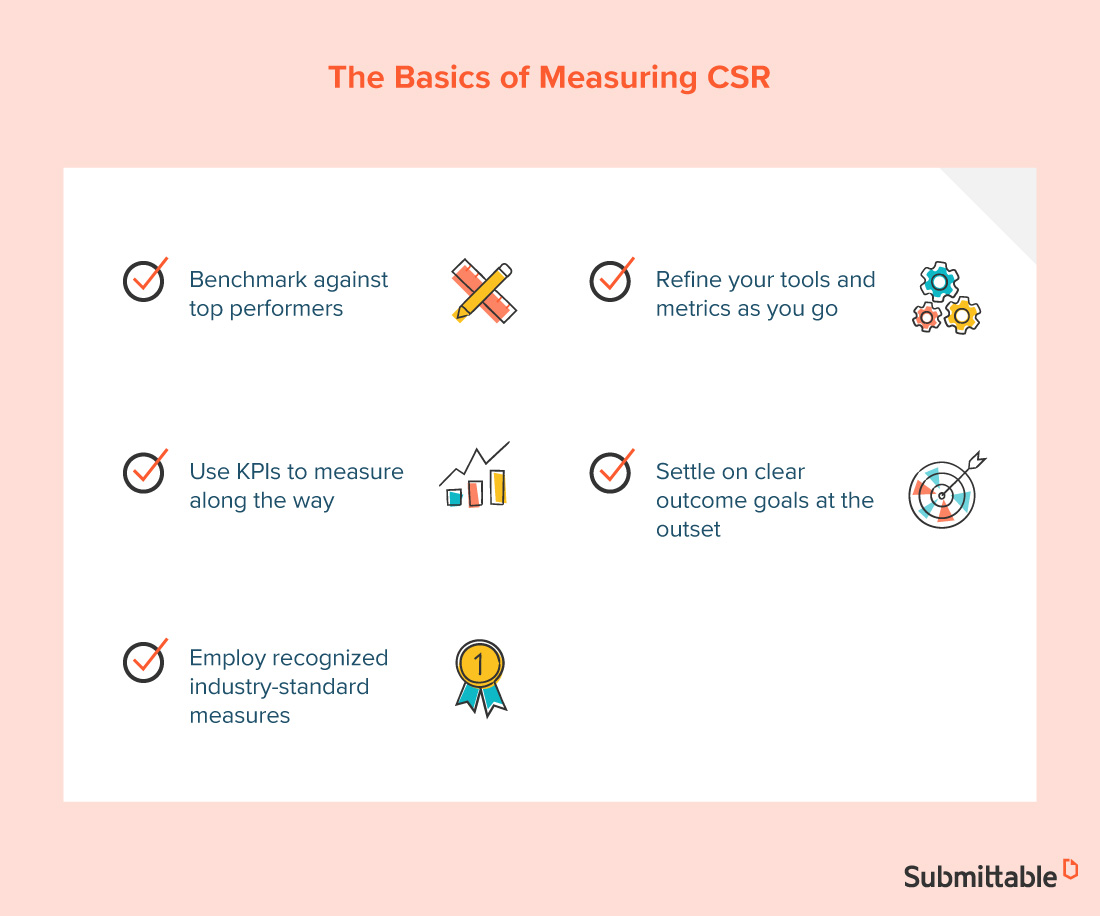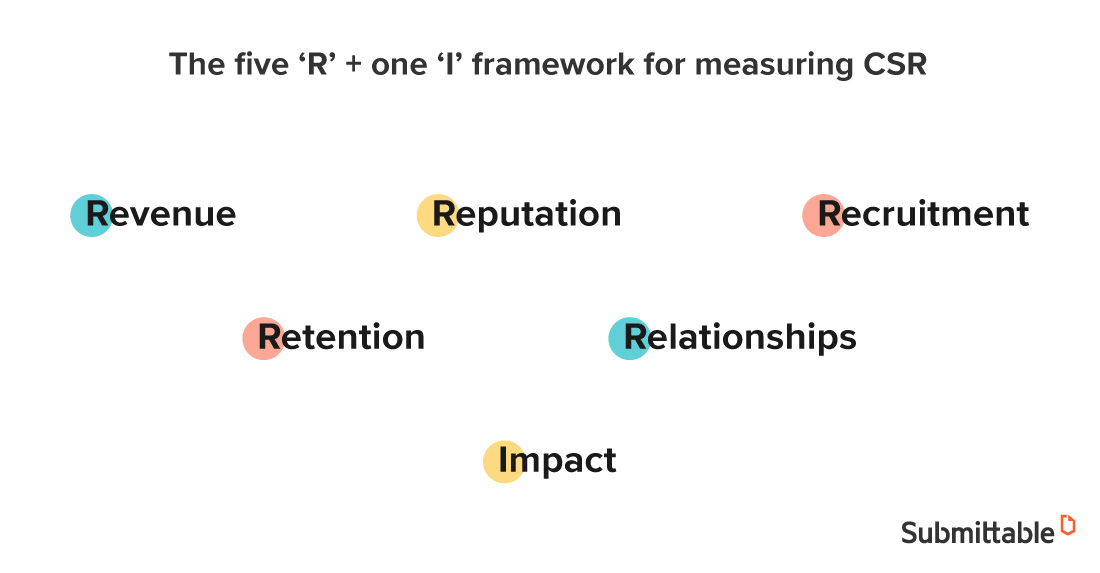Move over Ben & Jerry’s (but leave some Cherry Garcia, will ya?).
Corporate Social Responsibility (CSR) has gone mainstream and is no longer just the province of a few idealistic companies pushing their pet causes.
With more organizations placing CSR at the center of their corporate communications and strategy, and with more research showing that CSR is tightly tied to corporate success, knowing how to measure corporate social responsibility (CSR) performance has become essential.
At the highest level, such measurement allows organizations to make better choices about which programs to support, enhance the efficiency of their CSR initiatives, and enlist stakeholders (and shareholders) in the work.
These days, companies are eager to cite progress when it comes to their ESGs (environmental, social, and governance goals). Even investors are getting on board, taking a closer look at organizations’ ESG performance before they make decisions. There are even mutual funds out there that steer investments toward companies with solid ESG ratings.
The tangible benefits of measuring corporate social performance (and measuring it well) are clear. From reputational advantages that boost long-term business performance to customer preferences for companies with socially responsible records, organizations are realizing the myriad benefits of strong social impact work—and the benefits that come from maximizing their impact through tracking.
Companies are also more likely to attract investors and retain top talent with strong corporate social performance. They’re even less likely to face lawsuits and boycotts if they have a strong reputation for good CSR work.
The bottom line is that CSR is now firmly situated alongside organizational structures like digital communications and PR and should be evaluated as closely as those other tactics. Let’s talk about getting that done.
Evaluating corporate social performance as part of your overall organizational dashboard

“There’s no true set of universally understood or valued criteria on how CSR programs are measured,” noted Jerome Tennille, a social good professional who has worked with organizations like Ronald McDonald House Charities and Peace through Action USA.
As a consultant working with organizations to hone their social impact, Tennille shared that he looks for a few key criteria when measuring CSR programs:
- Transparency on progress towards communicated goals
- Strategic alignment between a company’s services and their CSR work
- Buy-in from senior leadership
- Demonstrated understanding of the issues being addressed by organizations
- Community assessment such as formal or informal evaluation of an organization’s CSR work by members of the community being served
That’s the “what” of measuring CSR, from a seasoned professional who has worked across the sector. But what about the how?
Shel Horowitz, Founder of Green of Profitable, knows a thing or two about how to measure corporate social performance. He counsels major business on combining business success with social impact.
When it comes to the question of evaluating CSR campaigns, Horowitz reminds practitioners that “each situation is different.” CSR measurement is as unique as the companies practicing it and the communities being served.
Horowitz is quick to point out organizations like d.light that keep a running total of their social impact on its website. Other organizations measure project-by-project or release annual reports that chronicle a year’s worth of impact. Shel Horowitz offered a few key pointers for getting the measurement of corporate social performance right:
1. Benchmark against top performers in corporate social performance
Horowitz believes that it’s important to look up to companies that go beyond CSR buzzwords.
Take Rocky Mountain Institute for example. They stand out, according to Horowitz, because they are “a think tank showing other companies how to go from energy consumers to energy producers using better building design and renewable resources.” The organization was part of a consortium that conducted a deep energy retrofit of the Empire State Building, which saves millions of dollars each year and makes it significantly more earth-friendly.
Another is Greyston Bakery. If you’ve ever had Ben & Jerry’s Brownie Batter ice cream flavor, then you’re familiar with their work. Horowitz highlights their employment policy as exemplary of a high-performing CSR organization:
“They are based in an economically challenged neighborhood just a couple of blocks from New York City. If you want a job there, you get on a list, and when you’re next on the list, you get offered a job–and the support you need to make it work–even if you’re an ex-addict, ex-felon, ex-mental patient, whatever. Suddenly, people who’ve never had stable employment have a proud block of time on their resume, good skills, and a positive attitude.”
For CSR experts like Horowitz, when it comes to corporate social performance, follow the leaders and then become a leader.
2. Refine your tools and metrics as you go
Measurement—in the CSR context—should be like breathing.
It should be a vital and involuntary part of your CSR programming.
How you measure your progress towards desired outcomes will sustain your whole CSR campaign. If you’re not measuring, even if you’re being successful, you don’t have an eye toward improvement. You’re flying blind towards those desired outcomes.
The CSR initiatives that achieve the greatest impacts treat measurement as an ongoing and cyclical process with feedback loops that enrich programs as they evolve. We’ll discuss specific tools and metrics in detail below, but know that constant refinement of how and what you measure will make all the difference in your CSR programming.
3. Use key performance indicators (KPIs) to measure along the way
Along the way to social impact, there will be lots of inputs and outputs.
Getting hung out on vanity metrics will be tempting. You’ll need to understand the difference between activity measures and outcome metrics in your CSR work. Armed with a firm grasp of each, you can leverage them to build out your KPIs.
Think of these KPIs as your little yellow brick road leading towards the eventual outcomes you seek.
For example, if your eventual outcome is to increase literacy rates for kids in a particular neighborhood, you’ll need a few activity measures that look at inputs like book donations, library programming, and perhaps even increased tutoring hours.
On the outcome metrics side, you might want to look at student reading levels, standardized test scores, and assessment from professional educators on students’ literacy gains as your CSR programs move forward.
Juggling these KPIs while measuring them over time will help you hone your CSR initiatives over time.
4. Settle on clear outcome goals at the outset
It’s fine to have a big, ambitious vision.
But when it comes to CSR work, make sure it’s grounded in community perspectives and diligent research. As mentioned above, any big outcome goals should be backed by a well-thought out set of KPIs that, if achieved, clearly demonstrate traction towards that goal over time.
Remember that this is a highly-iterative process. In CSR work, the facts on the ground change daily.
Oftentimes you will begin with a big goal, jump to your KPIs, only to realize that you could be using a better tool to measure those KPIs and need to slightly revise things.
The key here is coming up with a shared vision that enlist external and internal stakeholders and that is aligned to the assets all parties are bringing to bear on the CSR programming.
If you’ve got buy-in from all necessary parties at a technical and emotional level, you’re likely in a good place.
5. Employ recognized industry-standard measures
When it comes to measuring corporate social performance, Amanda Ponzar has some recommended reading for the class.
Ponzar, the Chief Communications and Strategy Officer at Community Health Charities, shared that “Dave Stangis’ book 21st Century Corporate Citizenship is a very practical guide” for organizations looking to “identify the best issues to work on for your company and the guidelines to put in place.”
And while there’s no unified standard for measurement of CSR campaigns (in part because the work is so different from context to context), there are some industry-standard tools out there:
- CommunityMark: A top measurement tool for community involvement
- GRI: The first global standards for sustainability reporting
- SASB: Measuring the financial impacts of sustainability
- B Corp certification: For aligning company practices to an array of CSR goals
- UN Frameworks: Global compacts such as the UN Sustainable Development Goals that guide countries and organizations towards greater sustainability and corporate responsibility
- International Labor Organization supplier frameworks: For companies interested in ensuring human rights within the supply chain
As CSR practice grows, expect to see more industry benchmarking tools such as these being embraced and utilized by organizations of all stripes.
How to evaluate corporate social performance using modern tools for corporate giving management

Jerome Tennille believes that communities being served by CSR initiatives should set their own desired outcomes.
Let’s call it community social performance. In other words, how does your corporate social performance measure up in the eyes of the community stakeholders with whom you’re working.
How are they experiencing the changes you’re helping to facilitate?
These are big questions and they’re not always easy to answer when you boil them down to qualitative and quantitative measures for CSR. Tennille believes you need a healthy mix of both types of measures and that they should be “connected to program outcomes that demonstrate actual change or progress.”
For social good experts like Tennille, an “ideal dashboard [for CSR] would be one that captures inputs, outputs and resulting outcomes.” Stressing the paramount importance of outcomes, Tennille urges CSR practitioners to drill down to outcomes that “quantify performance and showcase the success of CSR programs.”
While outputs show what was created and inputs show what was spent, outcomes demonstrate change or progress over time as a result of actions and should be the focal point of measuring corporate social performance, according to Tennille.
At a higher level, a good overarching framework for understanding corporate social performance addresses both organizational priorities alongside social impact goals (with key sub-metrics):
- Revenue: Cost savings, new customer acquisition, customer retention
- Reputation: Brand awareness, measurable improvements in consumer perception
- Recruitment: Amount of top talent attracted to the organization
- Retention: Increased employee retention, engagement, and satisfaction
- Relationships: Improved business partnerships
- Impact: Measurable positive outcomes based on community assessments and KPIs
Measuring along all of these dimensions is complex work. And you need a good CSR data dashboard.
One way to ensure that your CSR program is firing on all cylinders and measuring up along all of these criteria is to manage it using an all-in-one CSR software.
With all of your CSR initiatives centralized and coordinated through one system, your team is better positioned to pull the relevant data you need to make strategic decisions about corporate social performance.
In other words, put in place the best possible corporate giving management system that allows you CSR programs to really perform and achieve the social change you seek.

